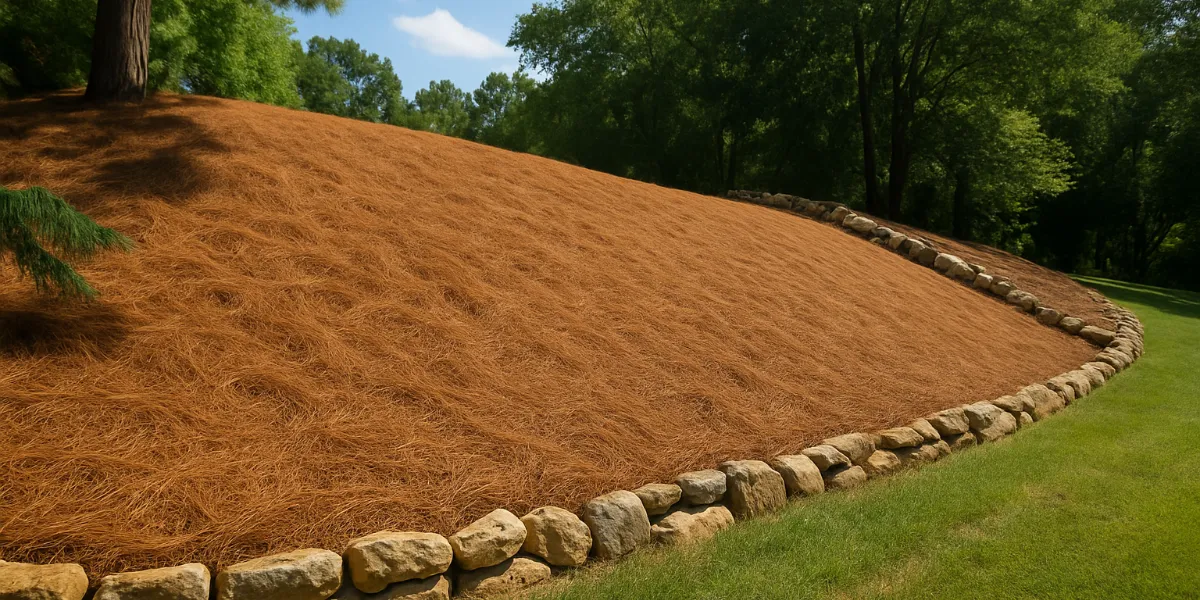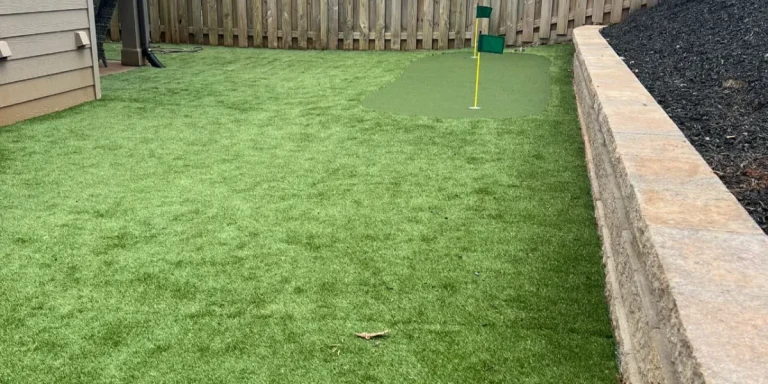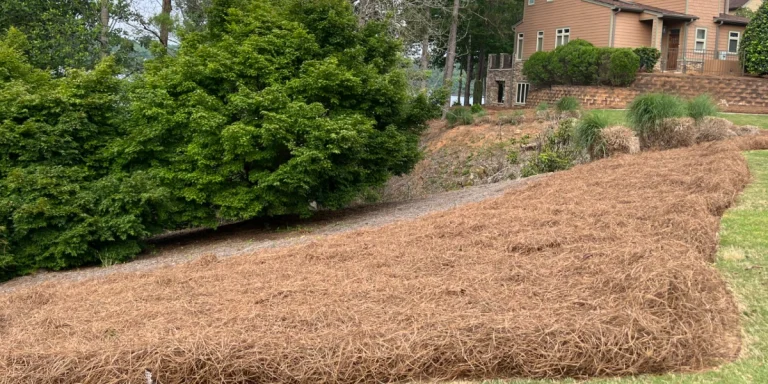How to Keep Pine Straw in Place on Windy Hillsides
Pine straw is a popular and effective ground cover for landscapes across Upstate South Carolina. It offers excellent weed control, helps retain soil moisture, and creates a clean, natural look around trees and garden beds. But if your property includes sloped areas—or if you live in a location exposed to frequent wind—keeping pine straw in place can be a challenge.
At Morales Landscaping & Tree Service, we frequently install pine straw on steep and uneven terrain. In this post, we’ll explain why pine straw tends to shift or blow away and share proven techniques to keep it firmly anchored, even on windy hillsides.
Why Pine Straw Moves on Slopes
Pine straw is lightweight by nature, which makes it easy to install—but also easier for wind and water to move. Sloped landscapes, in particular, create conditions that accelerate erosion and displacement.
Common causes of pine straw movement include:
-
- Wind exposure – Open hillsides are more vulnerable to gusts
- Improper installation – Thin or loosely applied pine straw doesn’t lock in place
- Rain runoff – Water flowing downhill can carry straw along with it
- Lack of edging or containment – Beds without clear boundaries allow straw to migrate easily
Fortunately, with the right materials, techniques, and professional care, you can keep your pine straw mulch looking neat and in place year-round.
Best Ways to Keep Pine Straw From Blowing or Sliding
Keeping pine straw secure on a slope requires more than just spreading it—especially in windy or erosion-prone areas. It involves smart installation techniques, physical barriers, and sometimes more advanced drainage or erosion control solutions.
1. Apply the Right Depth
Applying too little pine straw is one of the most common reasons it ends up blowing away.
Here’s what you should know:
-
-
- Apply at least 3 to 4 inches of pine straw for proper weight and coverage.
- Thicker layers help needles lock together naturally, resisting wind and light foot traffic.
- Deeper mulch beds provide better insulation for soil and roots during extreme temperatures.
- Avoid over-fluffing, which can reduce compaction and make the straw more prone to movement.
-
At Morales Landscaping & Tree Service, we ensure every installation has the proper depth to prevent wind displacement and maintain an attractive appearance.
2. Use Pine Straw Netting or Erosion Matting
Covering newly applied pine straw with netting is one of the most effective ways to prevent displacement.
Situations where netting helps most:
-
-
- New construction sites with loose or disturbed soil.
- Bare hillsides where vegetation hasn’t yet taken root.
- Areas exposed to regular wind gusts or water runoff.
- Steeply graded banks where straw would otherwise slide downhill.
-
We often use biodegradable jute netting or erosion blankets, which decompose naturally over time while protecting your mulch during the critical settling period.
Morales Landscaping & Tree Service can install erosion control netting as part of your pine straw project, especially on properties in higher-risk locations.
3. Install Natural or Stone Edging
Creating a physical border around your pine straw beds helps contain the material and improves the overall appearance of your landscape.
Recommended edging materials include:
-
-
- Natural fieldstone for a rustic, organic look.
- Steel or aluminum edging for clean, modern lines.
- Landscape timbers or pressure-treated wood for cost-effective solutions.
- Paver or brick borders that match existing hardscapes.
-
Benefits include:
-
-
- Stops pine straw from drifting into grass or walkways.
- Creates a defined visual edge that enhances curb appeal.
- Reduces the need for constant cleanup or reshaping.
-
Morales Landscaping & Tree Service can incorporate edging into any mulch or pine straw installation for both functional and aesthetic improvements.
4. Choose the Right Type of Pine Straw
Not all pine straw performs the same—especially on hillsides.
Longleaf pine straw is recommended for sloped areas because:
-
-
- Its longer, thicker needles naturally interlock better than slash pine.
- It forms a more stable and wind-resistant mat, even without netting.
- It lasts longer, requiring fewer refreshes per year.
- The rich, reddish-brown color holds up well in sun and rain.
-
While it may cost more upfront, longleaf straw often provides better value over time.
Morales Landscaping & Tree Service offers both longleaf and slash pine straw and will recommend the best fit for your property and conditions.
5. Compact the Straw After Installation
Proper compaction helps the straw settle into a cohesive, wind-resistant layer.
Simple steps to take:
-
-
- Lightly rake or press the straw into place after spreading.
- Tuck the edges against beds, trees, or edging for a more finished look.
- Allow a few days of settling time before major watering or foot traffic.
- Avoid over-fluffing, which can reduce interlocking strength.
-
At Morales Landscaping & Tree Service, we always include compaction as a final step in our pine straw installations to ensure long-term hold and clean presentation.
6. Improve Drainage and Water Flow
Water runoff can be just as damaging as wind when it comes to mulch on a slope.
What to consider:
-
-
- Is water flowing directly through your beds during rain?
- Are there low spots or bare soil patches indicating erosion?
- Do you notice mulch being washed into lawns or walkways?
- Is your downspout or driveway directing water toward the hillside?
-
Solutions we often install include:
-
-
- French drains to redirect subsurface water.
- Dry creek beds to carry surface runoff safely downhill.
- Drainage swales to slow and spread water across slopes.
- Retaining walls or terraces to break up slope grade.
-
Morales Landscaping & Tree Service specializes in drainage and erosion control strategies that keep your landscape stable and your mulch in place.
Why Professional Installation Matters
While pine straw seems easy to install, achieving long-lasting results on a slope takes more than spreading a few bales. Morales Landscaping has years of experience working with the hills and elevations common in Greenville and surrounding areas. We use proven strategies and professional tools to ensure your pine straw stays where it belongs—even through high winds and heavy rain.
We also offer landscape grading, bed edging, erosion control, and retaining wall construction to further protect sloped areas and prevent mulch displacement.
Proudly Serving Greenville and Nearby Communities
Morales Landscaping & Tree Service provides pine straw installation, erosion control, and full-service landscaping in:
-
- Greenville
- Clemson
- Easley
- Greer
- Landrum
- Salem
- Seneca
- Simpsonville
- Travelers Rest
Whether you're dealing with a small hillside garden or a large sloped yard, we offer expert solutions tailored to Upstate South Carolina’s terrain and weather.
Keep Your Pine Straw in Place—Call Us Today
Don’t let wind and runoff ruin your landscape.
If you’re struggling to keep pine straw in place on a slope or windy area, Morales Landscaping & Tree Service can help. We offer professional pine straw installation, custom edging, and erosion control solutions to keep your property looking its best.
Call today to request an estimate or schedule a consultation. We proudly serve Greenville, SC and surrounding areas with honest advice, skilled service, and lasting results.




